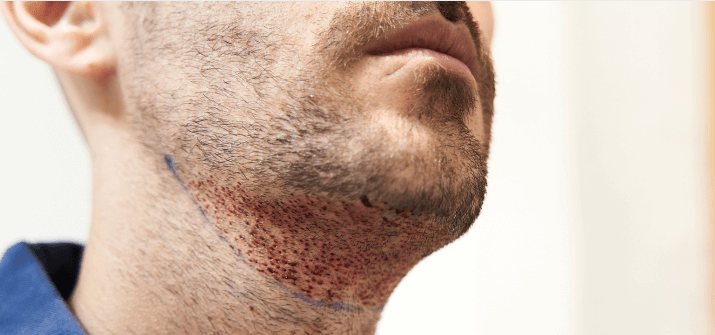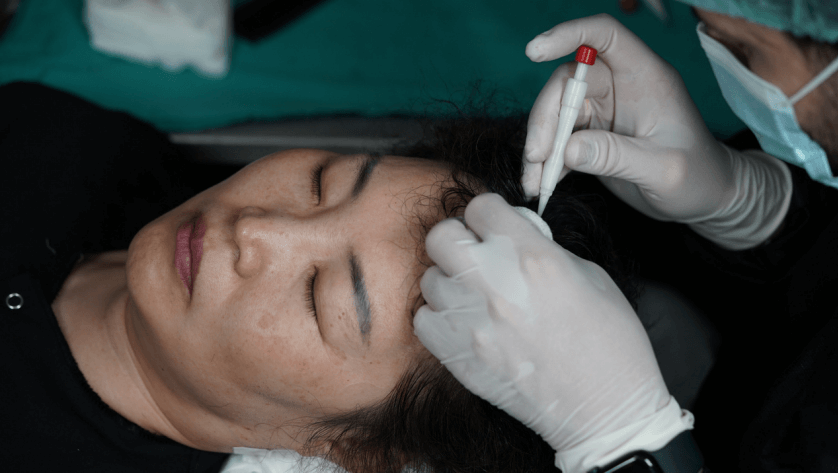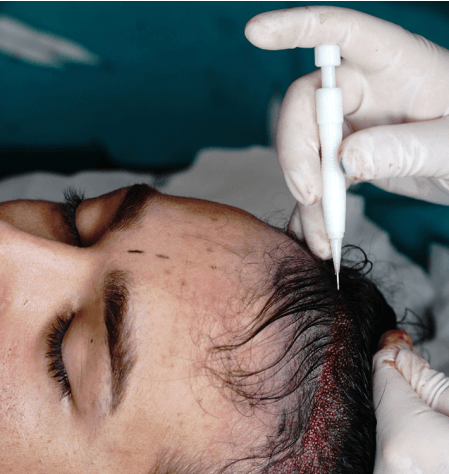BEARD AND MOUSTACHE TRANSPLANTATION
What is Beard and Moustache Transplantation?
Beard and moustache transplantation is a highly effective solution for those who want to enhance their appearance by filling in gaps or correcting irregularities in their facial hair. It involves moving hair grafts from the donor area to the desired beard or moustache area. These features are key elements of a man's appearance, and it's common for gaps or irregularities to occur due to genetic, hormonal, or other factors. Both the Direct Hair Implantation (DHI) and Follicular Unit Extraction (FUE) techniques are commonly used for this procedure. DHI involves extracting hair follicles from the donor area and directly implanting them into the desired location using a Choi implanter pen, allowing for accurate placement without the need for prior incisions. FUE, on the other hand, involves extracting individual follicles and then creating tiny incisions in the recipient area before implanting the follicles. Both methods offer several benefits and these procedures help restore or enhance facial characteristics, giving the person a more mature appearance.


What Are the Stages of Beard-Moustache Transplantation?
Before the operation, a consultation is conducted to review the patient's medical history and identify any genetic or hormonal factors contributing to beard and moustache loss. After determining the area to be transplanted and the number of hair follicles required, a beard and moustache transplant is carefully planned to ensure aesthetic natural appeal, considering the patient's preferences, facial structure, and hair growth patterns. The procedure involves the following steps, which vary slightly depending on whether the DHI or FUE method is used:
- Hair Follicle Extraction: In both DHI and FUE methods, hair follicles are extracted from the donor area.
- DHI Method: Using a Choi implanter pen, the extracted follicles are directly implanted into the desired area without the need for prior incisions. The pen creates the incision and inserts the follicle simultaneously, allowing for precise placement.
- FUE Method: Tiny incisions are first made in the designated areas as planned during the consultation. The extracted follicles are then inserted into these incisions by the doctor.
- Both methods are designed to ensure that the transplanted hair achieves a natural and aesthetically pleasing result, tailored to the individual's facial characteristics and preferences.
What Needs to Be Done After Beard and Moustache Transplantation?
After the operation, the doctor dresses the person and provides instructions on how to care for the area in the coming days. Beards andmoustaches enter a shock-shedding phase towards the end of the first month, and the desired result is usually achieved between four to eightmonths. In addition, the following precautions should be taken:
- Drink plenty of water, especially for the first three to four days.
- Avoid opening the mouth too wide while eating or yawning during the first ten days after the operation.
- Be careful not to touch the implanted zone when putting on or removing a shirt or T-shirt.
- Avoid alcohol, smoking, or using drugs.
- No sexual intercourse during this period
Frequently Asked Questions
The hair grafts are extracted from the backside of the head, which we determine as between two ears and above the neck. The reason for choosing this specific area as a donor (extraction zone) is that the hair grafts in this region are genetically encoded against inherent hair fall. If the extraction process from this region is performed with better quality artistry, hair fall will never occur for a lifetime. Therefore, we take the hair grafts from this region.
The implanted hair may fall out within 2-3 weeks after transplantation. This is a normal process. New hair will begin to grow approximately 3-4 months later, and you can see the final results after 6-12 months. Complete growth can take up to 18 months.
No, the implanted hair generally does not fall out again. Hair extracted from the back of the head is genetically resistant to hair loss and remains permanent. However, existing natural hair may continue to fall out with age, so additional transplantation may be necessary if needed.
The surgery is performed under local anesthesia, so there is almost no pain during the procedure. There may be mild discomfort or swelling after surgery, but this can generally be managed with mild painkillers. Most patients can return to normal activities the day after surgery.
You are welcome to come with your family. There may be an additional charge for companion accommodation, but this is optional. It may vary depending on the accommodation package, so please check the details when making a reservation. Generally, all services are included for one patient.
The operation time varies depending on the number of follicles to be transplanted. Generally, 1000-2000 follicles take 4-6 hours, 2000-3000 follicles take 6-8 hours, and 3000 or more follicles take 8-10 hours. The surgery is completed in one day, including rest time.
BEARD AND MOUSTACHE TRANSPLANTATION
How is a hair transplant performed?Beard and moustache transplantation is a highly effective solution for those who want to enhance their appearance by filling in gaps or correcting irregularities in their facial hair. It involves moving hair grafts from the donor area to the desired beard or moustache area. These features are key elements of a man's appearance, and it's common for gaps or irregularities to occur due to genetic, hormonal, or other factors. Both the Direct Hair Implantation (DHI) and Follicular Unit Extraction (FUE) techniques are commonly used for this procedure. DHI involves extracting hair follicles from the donor area and directly implanting them into the desired location using a Choi implanter pen, allowing for accurate placement without the need for prior incisions. FUE, on the other hand, involves extracting individual follicles and then creating tiny incisions in the recipient area before implanting the follicles. Both methods offer several benefits and these procedures help restore or enhance facial characteristics, giving the person a more mature appearance.



Before the operation, a consultation is conducted to review the patient's medical history and identify any genetic or hormonal factors contributing to beard and moustache loss. After determining the area to be transplanted and the number of hair follicles required, a beard and moustache transplant is carefully planned to ensure aesthetic natural appeal, considering the patient's preferences, facial structure, and hair growth patterns. The procedure involves the following steps, which vary slightly depending on whether the DHI or FUE method is used:
- Hair Follicle Extraction: In both DHI and FUE methods, hair follicles are extracted from the donor area.
- DHI Method: Using a Choi implanter pen, the extracted follicles are directly implanted into the desired area without the need for prior incisions. The pen creates the incision and inserts the follicle simultaneously, allowing for precise placement.
- FUE Method: Tiny incisions are first made in the designated areas as planned during the consultation. The extracted follicles are then inserted into these incisions by the doctor.


After the operation, the doctor dresses the person and provides instructions on how to care for the area in the coming days. Beards andmoustaches enter a shock-shedding phase towards the end of the first month, and the desired result is usually achieved between four to eightmonths. In addition, the following precautions should be taken:
pages.beardTransplantation.t6
pages.beardTransplantation.p6
pages.beardTransplantation.t7
pages.beardTransplantation.p7
pages.beardTransplantation.t8
pages.beardTransplantation.p8
pages.beardTransplantation.t9
pages.beardTransplantation.p9


 Deutsch
Deutsch
 English
English
 français
français
 italiano
italiano
 Türkçe
Türkçe
 русский
русский
 한국어
한국어


